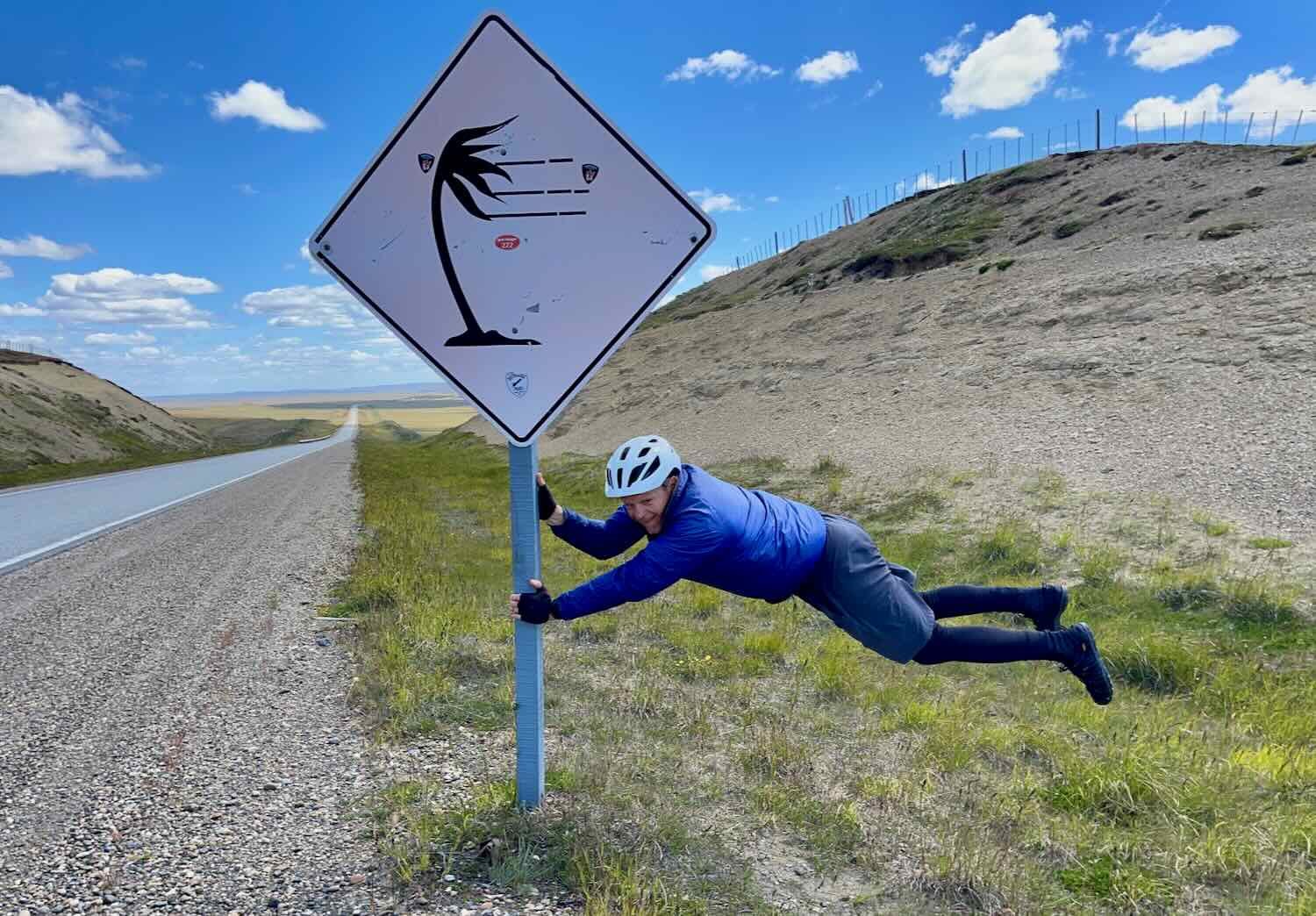Cycling Tierra del Fuego, Part 1: Ushuaia to Río Grande, Argentina
27 November - 13 December 2024
27 Nov - Buenos Aires to Ushuaia, Argentina (flight)
28 Nov-5 Dec - Exploring Ushuaia, Argentina
6 Dec - Ushuaia to Paso Garibaldi, Argentina (28.8 mi, 46.4 km)
7 Dec - Paso Garibaldi to Tolhuin, Argentina (36.7 mi, 59.1 km)
8 Dec - Rest day in Tolhuin, Argentina
9 Dec - Tolhuin to Camping Norte, Argentina (38.3 mi, 61.6 km)
10 Dec - Camping Norte to Río Grande, Argentina (30.8 mi, 49.6 km)
11-13 Dec - Weather Delay in Río Grande, Argentina
Ushuaia Argentina - ‘The End of the World’
Tierra del Fuego, the Land of Fire… for most people who live north of the Equator, the very name conjures images of frozen seas, desperate shipwrecks, and rugged adventure - even if they’re not exactly sure about where it is.
In case you can’t quite recall your world geography, Tierra del Fuego is an archipelago of cold, mountainous, rocky, windswept islands at the very southern tip of South America. There, the long Andes mountain range finally descends into the frigid southern ocean. It makes an appearance in world history lessons as a distant place where European explorers in sailing ships gained fame and fortune. Ferdinand Magellan was the first European to see Tierra del Fuego when he sailed around the world in 1520. Charles Darwin studied the islands from aboard the English ship, The Beagle, in 1833-34. And the waters around the tip of South America are known as the Drake Passage, named after the privateer Sir Francis Drake who ended up there by accident during a violent storm in 1878.
Glance at a world map, and you’ll notice that South America reaches further south than any other continent. As a result, Tierra del Fuego is the closest you can get to Antarctica without actually crossing the sea.
Nestled along the southern shore of one of Tierra del Fuego’s many islands lies a city named Ushuaia (pop. 82,600), affectionately known as El Fin del Mundo (The End of the World). As the nickname suggests, this city is famous among world travelers because it is literally the end of the road. There, the Pan-American Highway has its terminus at the Beagle Channel, named after the British ship that first surveyed the waterway with Charles Darwin on board. For people like us who aspire to travel the full length of the Americas, Ushuaia is the place to begin if you are heading north.
Resuming our Journey in Tierra del Fuego
It had been more than four months since PedalingGal’s bike accident in Colombia. She was fully recuperated, and we were eager to get back into bicycle touring mode.
After weighing several options, we decided that the best way to complete our trip would be to fly to Ushuaia, and cycle northward to reconnect with our initial route in Colombia. Voilà - Alaska to Patagonia in two segments, with a ‘flip-flop’ in Colombia.
December is the beginning of the Patagonian summer, and the perfect time to start cycling northward from the tip of South America. So we packed up our bicycles and flew from Buenos Aires to the city at the far, southern end of the Pan-American Highway to resume our bike tour across the Americas.
We made it to Ushuaia, the southernmost city on the Pan-American Highway. Tierra del Fuego, Argentina. Copyright © 2019-2024 Pedals and Puffins.
We’re Not in the Tropics Anymore
Everything about Ushuaia was a huge contrast with the warm, tropical lands where we had been living for the past year. The snow-capped peaks of the southern Andes enveloped Ushuaia, confining it to a narrow strip of land between the mountains and the ocean channel. Even though it was the beginning of summer, it was quite chilly, with nightly temperatures hovering around freezing, and daily highs rarely reaching 50F (10C). The days were really long, with only about four hours of darkness during the night. And it was common for a fierce wind to blow through town, when strong ocean breezes gained speed as they raced though gaps between the mountains.
The 5 Hermanos (‘five brothers’) Mountain is one of the more recognizable peaks bordering the city. It is part of the Martial Mountains - a ridge at the far-southern end of the Andes. Although it was the beginning of summer, snow still clung to the chiseled slopes. Ushuaia, Tierra del Fuego, Argentina. Copyright © 2019-2024 Pedals and Puffins.
A view across Ushuaia Bay, a sheltered spot along the Beagle Channel. The mountain range on the far side of the channel is actually in the country of Chile. Taken from Ushuaia, Tierra del Fuego, Argentina. Copyright © 2019-2024 Pedals and Puffins.
The wind in Ushuaia often blew at speeds of 25-40 mph (40-56 km/h) or more. It was pretty typical to see flags fully unfurled in the stiff winds. Even very large flags, the size of cars, were fully unfurled. Ushuaia, Tierra del Fuego, Argentina. Copyright © 2019-2024 Pedals and Puffins.
Although Ushuaia has a dock big enough to handle container ships, it’s not a significant international port. The container ships that stop there mainly unload goods for local use. Massive, international cargo ships sailing around the tip of South America mostly use the Drake Passage, which lies further south. These days the biggest ships that dock in Ushuaia are hefty cruise ships. Most of them specialize in passenger cruises to Antarctica, although a few also sail along the coasts of Argentina and Chile.
The dock in Ushuaia stayed pretty busy with container ships, cruise ships, fishing boats and navy ships. Ushuaia, Tierra del Fuego, Argentina. Copyright © 2019-2024 Pedals and Puffins.
Only a small area was set aside for container storage, since most of the goods were for local use. Ushuaia, Tierra del Fuego, Argentina. Copyright © 2019-2024 Pedals and Puffins.
Originally a WWII tugboat in the British Navy, the Saint Christopher ended its career as a salvage boat in the Beagle Channel. It ran ashore after suffering engine trouble in the late 1950s, and has remained there ever since. In the background, two cruise ships rest along the main dock. Ushuaia, Tierra del Fuego, Argentina. Copyright © 2019-2024 Pedals and Puffins.
Exploring the City at ‘The End of the World’
It comes as no surprise that Ushuaia has been dubbed El Fin del Mundo (The End of the World). Although there are small settlements further south, Ushuaia is 30x more populous than the next-biggest town to its south. Plus, none of the others can be reached by road.
Perhaps that is why the folks of Ushuaia seem fascinated by just how far they are from other parts of the world. At times it seemed like every street corner in the city hosted signs celebrating Ushuaia’s status as the end of the road. One of the most popular motifs was a sign post with various markers telling you how far away you were from other, more familiar places. We easily saw 10+ of these types of signs posted around town.
This sign said we were 17,850km from Alaska (where we started). That must be ‘as the crow flies,’ because we will end up cycling a lot farther. By the time we’re done our journey across the Americas, we will have cycled over 35,000km. Ushuaia, Tierra del Fuego, Argentina. Copyright © 2019-2024 Pedals and Puffins.
Overlanders like to mark their trail with stickers, and Ushuaia is a favorite destination for Overlanders. You can barely read this sign, given all the stickers left behind by travelers happy to have reached the end of the world. The sign reads “Ushuaia fin del mundo” (Ushuaia the end of the world). Ushuaia, Tierra del Fuego, Argentina. Copyright © 2019-2024 Pedals and Puffins.
Most of the touristy businesses line one main street through town. Along San Martín Avenue, we found a wide variety of international cuisine mingling with trendy shops selling outdoor clothing and gear. Looking down the road, you can see the 5 Hermanos Mountain in the distance. Ushuaia, Tierra del Fuego, Argentina. Copyright © 2019-2024 Pedals and Puffins.
One of our key tasks was to complete some last-minute bicycle maintenance before heading out of town. The mechanic at Home Bike was wonderful in helping us change one of our tubeless tires, and had just the part we needed to replace a bent front wheel skewer. 100% recommended. Ushuaia, Tierra del Fuego, Argentina. Copyright © 2019-2024 Pedals and Puffins.
Monument to the ‘Ancient Settlers’. Tierra del Fuego has been inhabited by hardy, indigenous people for at least 10,000 years. Ushuaia, Tierra del Fuego, Argentina. Copyright © 2019-2024 Pedals and Puffins.
Statues depict a convict attempting to escape from a small window in a local history museum, pursued by police. From 1902-1947 the city was primarily a penal colony, and prison labor built much of the early infrastructure. Today, the yellow-and-navy striped prison shirts are a popular souvenir item. Ushuaia, Tierra del Fuego, Argentina. Copyright © 2019-2024 Pedals and Puffins.
Beer is VERY popular, and many brands are named for regional icons (like The Beagle, Darwin’s ship). Tierra del Fuego, Argentina. Copyright © 2019-2024 Pedals and Puffins.
A nearby penguin colony is a popular tourist attraction, and the inspiration for quite a few cute souvenirs. Ushuaia, Tierra del Fuego, Argentina. Copyright © 2019-2024 Pedals and Puffins.
Restaurants ranged from chic, modern cafes to cluttered, historic spaces. Inside the Ramos Generales Cafe, we dined among shelves filled with antiques. Ushuaia, Tierra del Fuego, Argentina. Copyright © 2019-2024 Pedals and Puffins.
One of our favorite ways to warm up on cold, windy days was to enjoy a hot ‘submarino’ drink, an Argentinian specialty. Basically you get a big chunk of dark chocolate (the submarine) that you melt in a glass of very, very, hot milk. It’s fun, really delicious, and leaves you feeling nice and toasty.
Ready to dunk our chocolate submarinos in the milk. Ushuaia, Tierra del Fuego, Argentina. Copyright © 2019-2024 Pedals and Puffins.
The finished product: delicious, authentic, hot chocolate. Ushuaia, Tierra del Fuego, Argentina. Copyright © 2019-2024 Pedals and Puffins.
Hanging Out with Penguins
If you can’t make it to Antarctica on a cruise, you can still see penguins within a couple of hours drive of Ushuaia. In fact, there are two species of penguins that breed on an island nearby. And like many folks before us, we could hardly pass up the opportunity to visit the penguin colony. The only way folks like us were allowed to visit the colony was on a guided tour, so we signed up for a day trip that took us out to Isla Martillo.
After a 1.5 hr drive through the forest, we boarded a zodiac boat that took us out to the island. On board, our guide explained the rules that would help us keep from disturbing the penguins during our visit. Isla Martillo, Tierra del Fuego, Argentina. Copyright © 2019-2024 Pedals and Puffins.
The first penguins we saw were these Magellanic penguins. With nearly 5,000 breeding pairs on the island, they are definitely the most numerous species. These penguins mate for life, live about 25 years, and nest in burrows. They were very sweet looking, although they sounded like donkeys braying when they let out a bellow. Isla Martillo, Tierra del Fuego, Argentina. Copyright © 2019-2024 Pedals and Puffins.
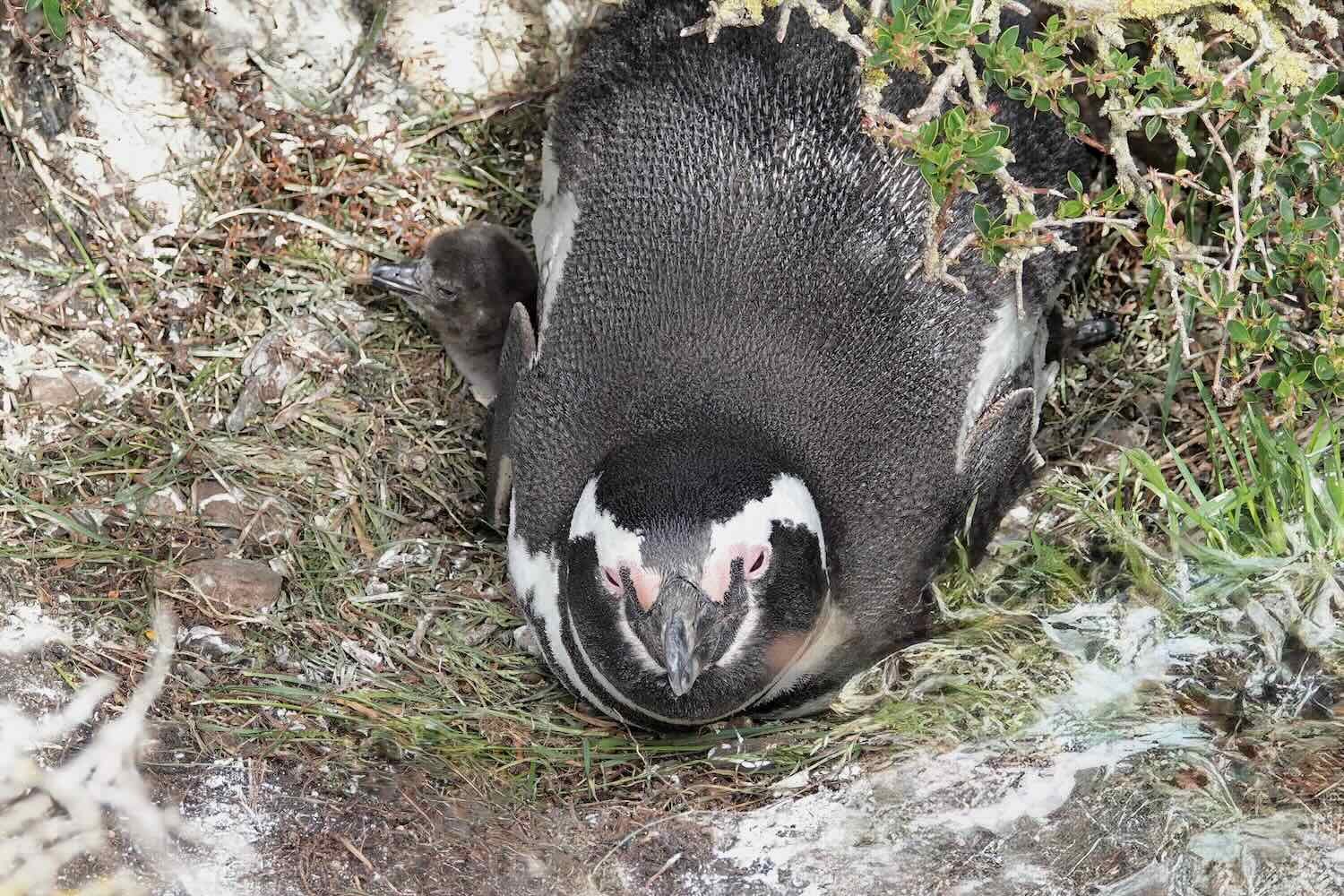
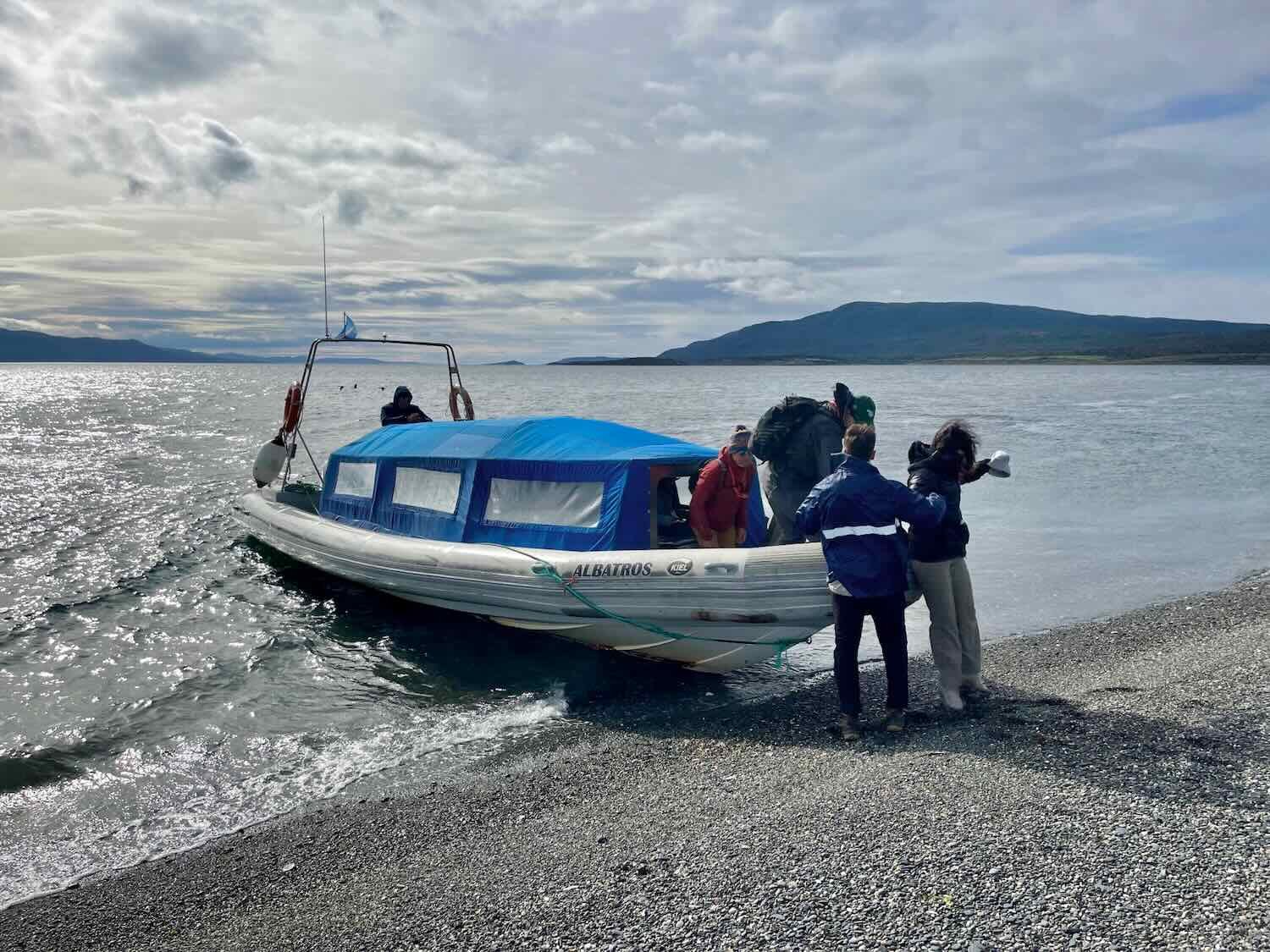
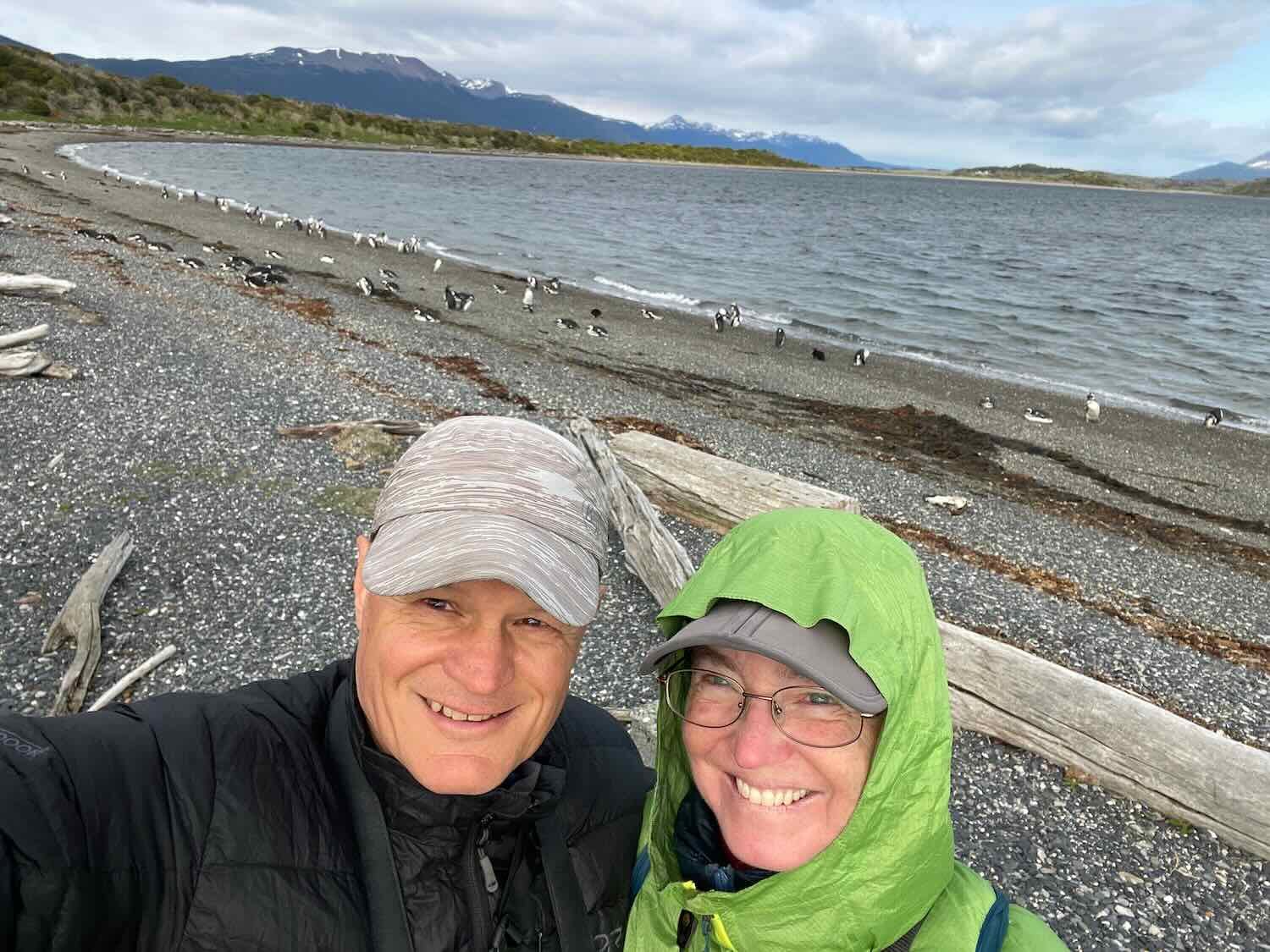

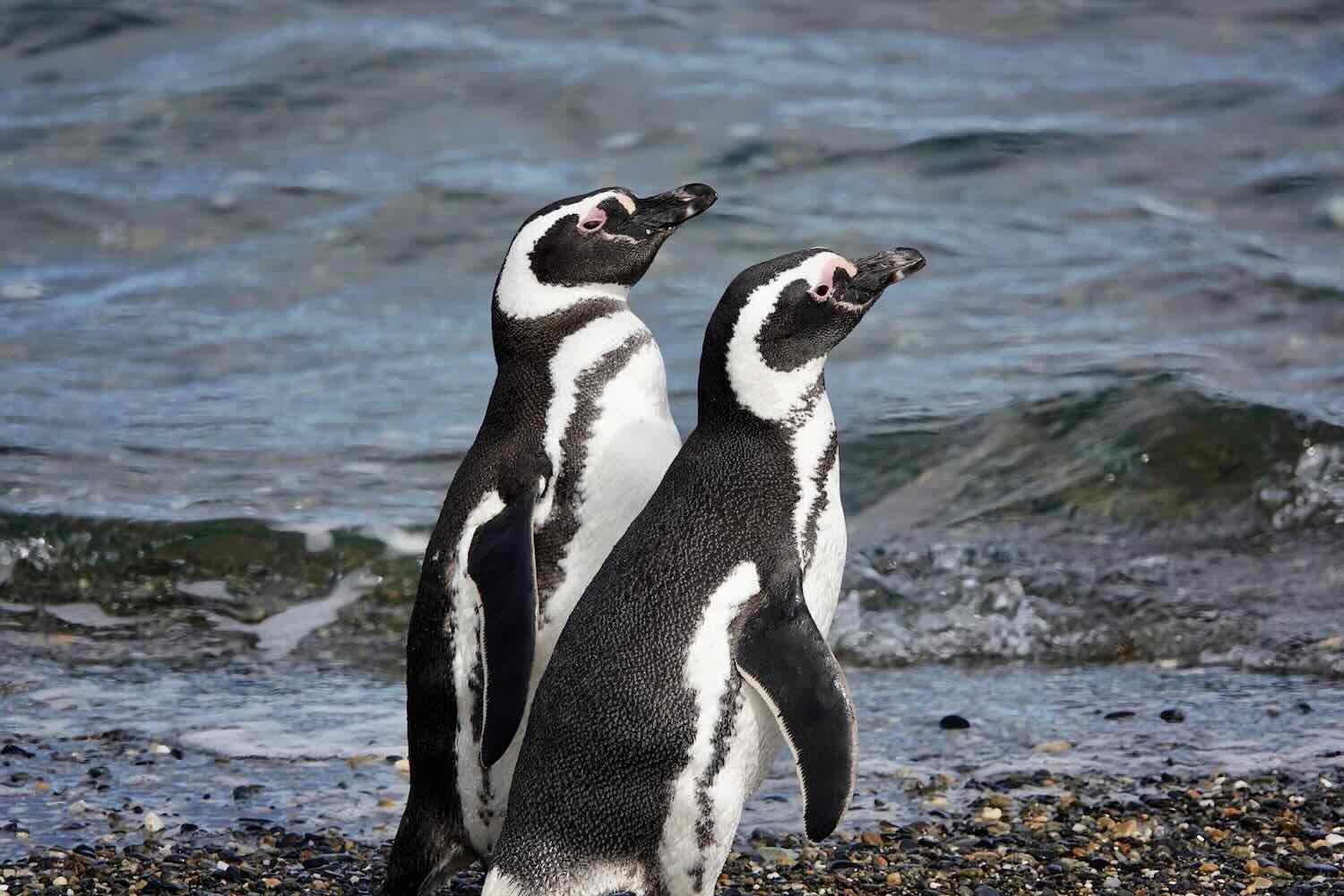
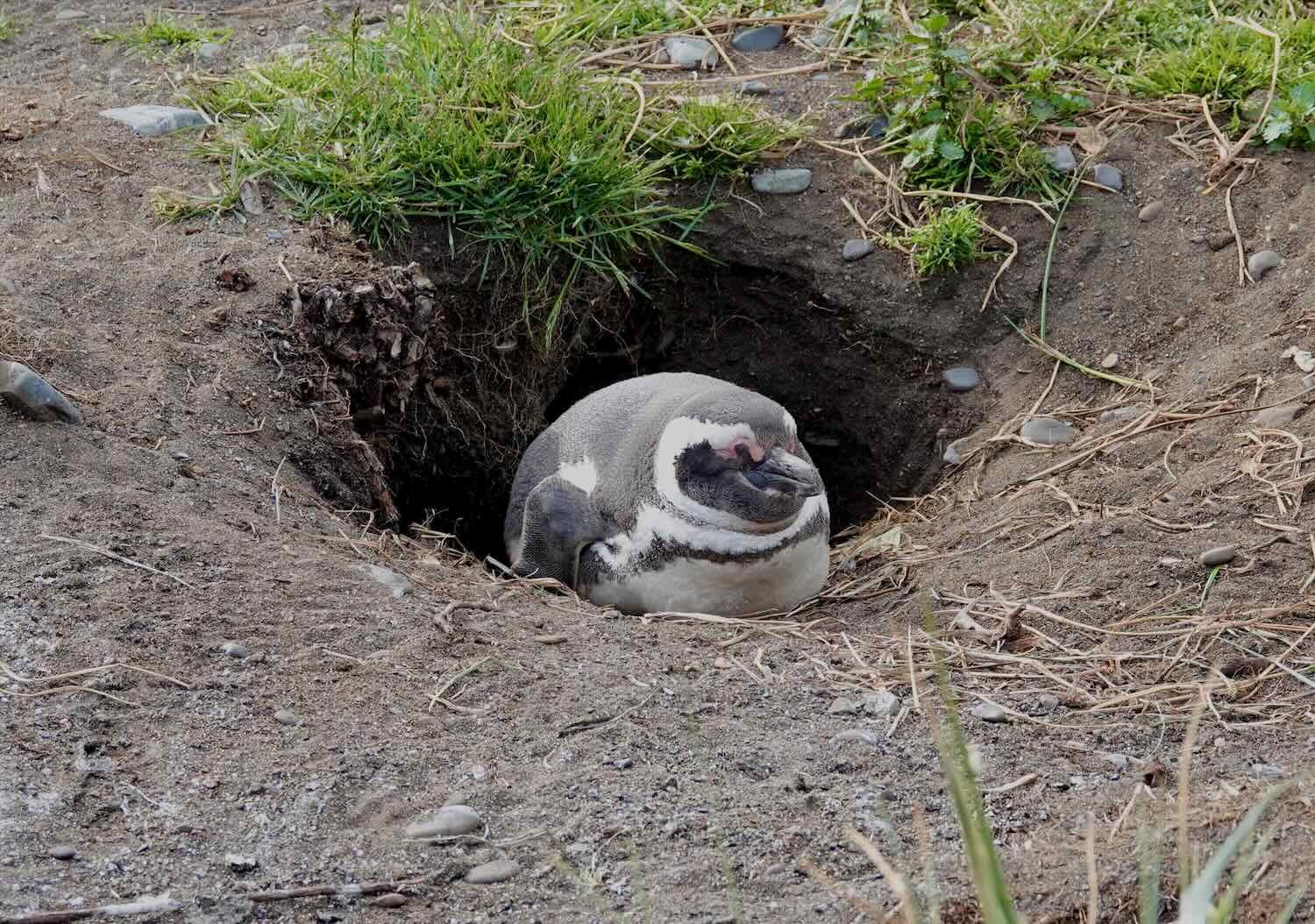
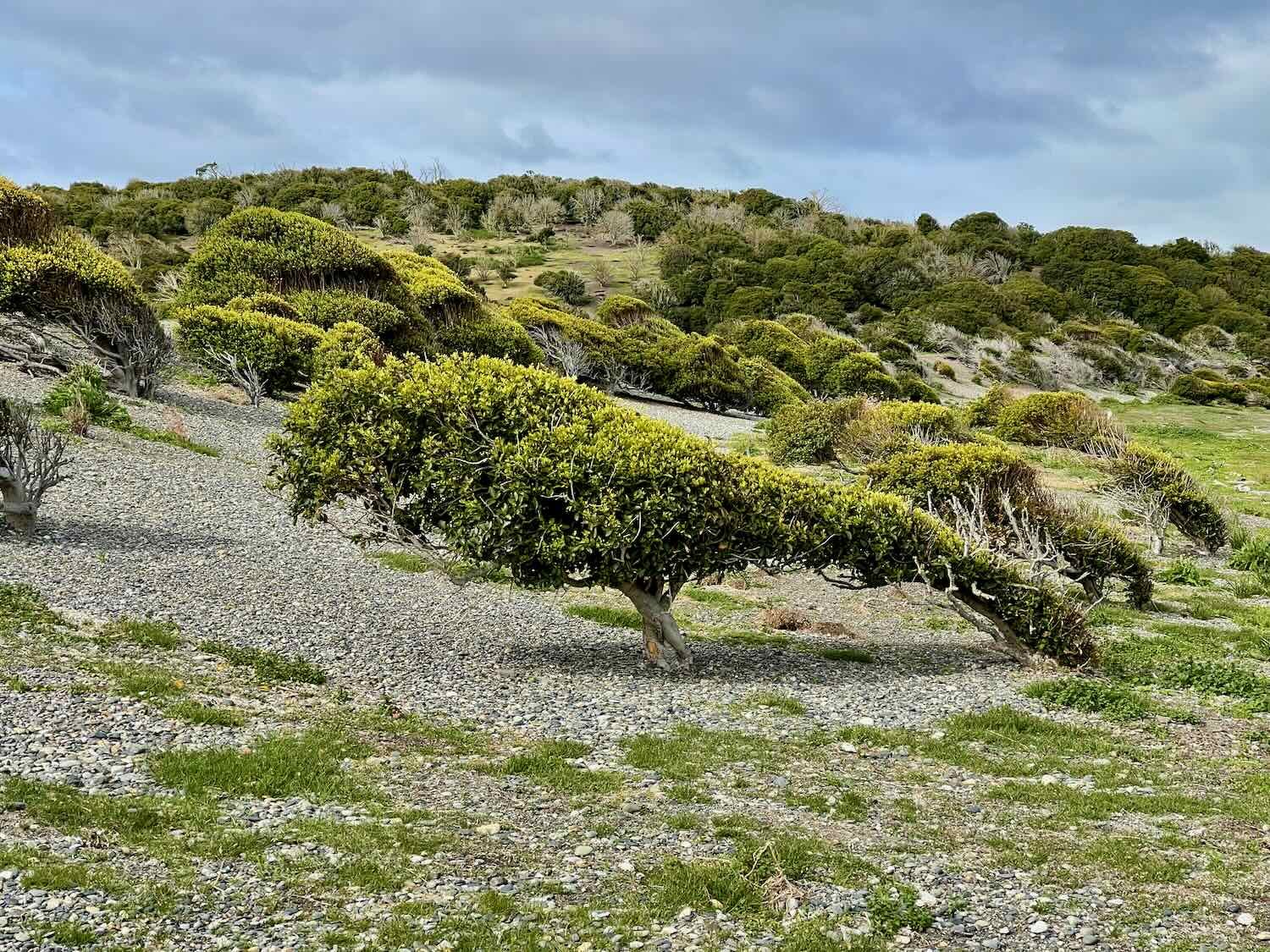
The other species we saw, Gentoo penguins, were much less common - with only 88 breeding pairs at this site. Gentoo penguins are the third-largest penguin species (behind Emperor and King penguins). They may stick with a mate for several seasons, but often change partners after that. Fun facts: they are the fastest penguins, achieving swimming speeds of up to 36 km/h (22.4 mph). And when they let out a bellow, they sound like the Star Wars Wookiee, Chewbacca. Isla Martillo, Tierra del Fuego, Argentina.
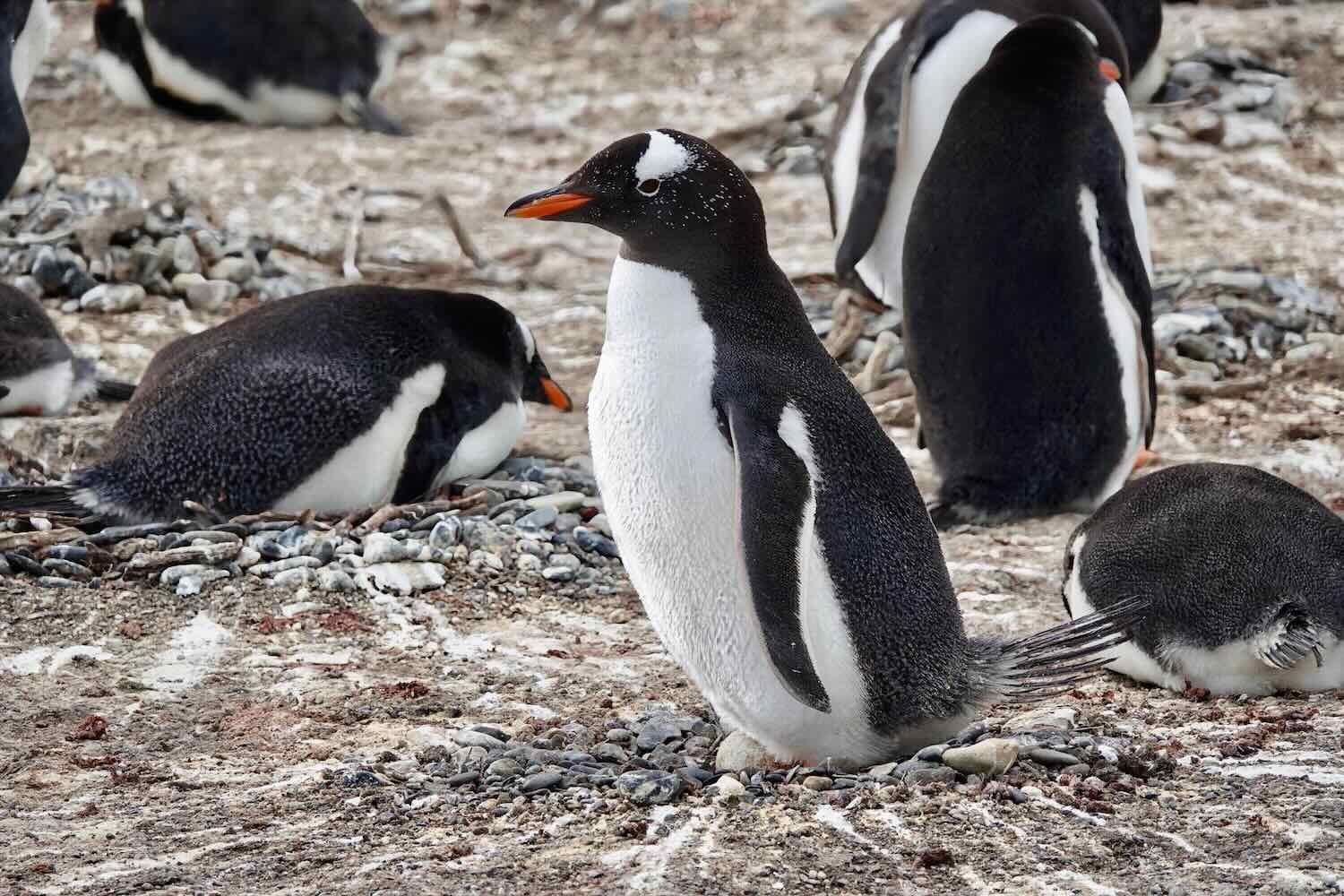
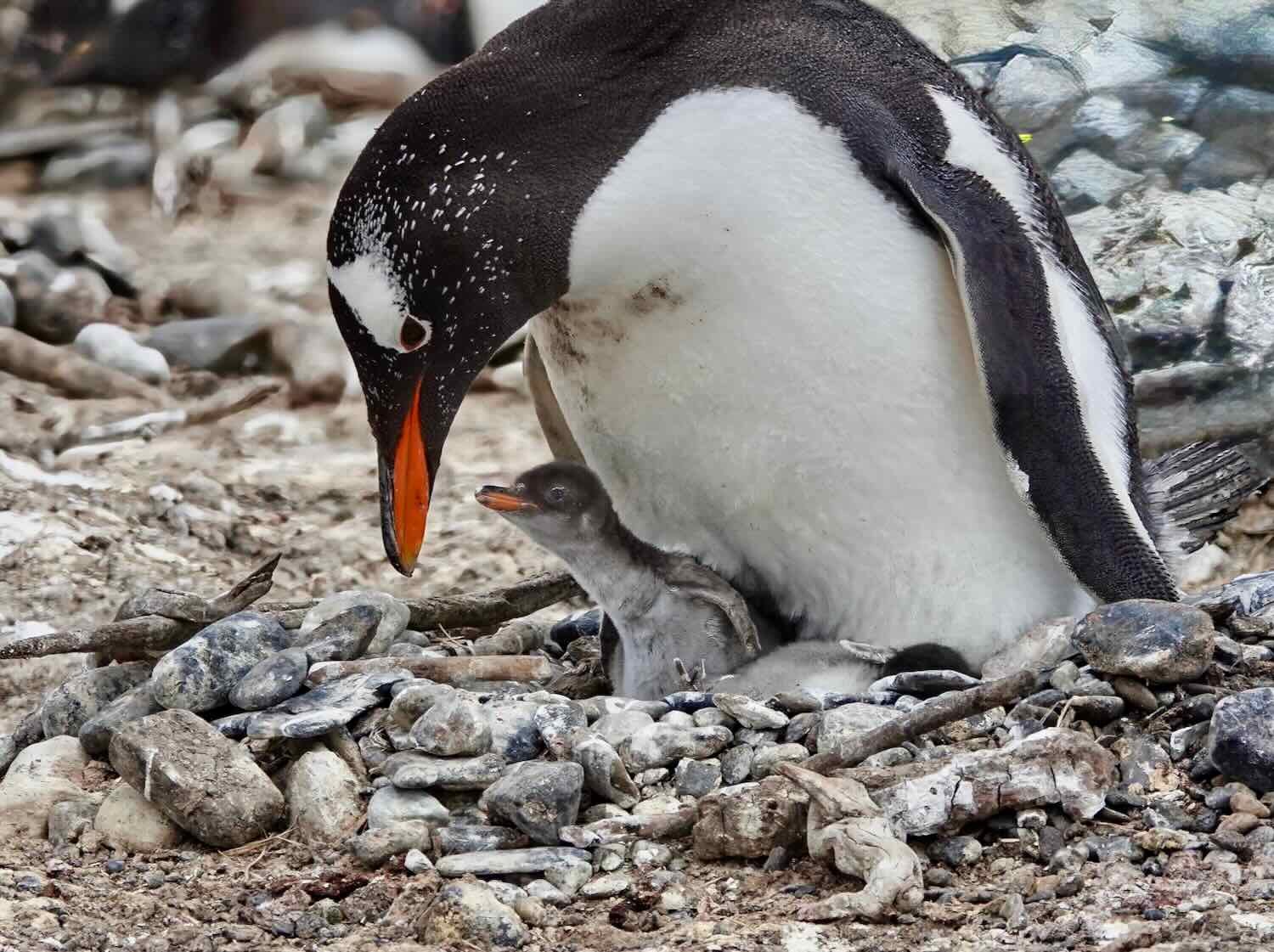
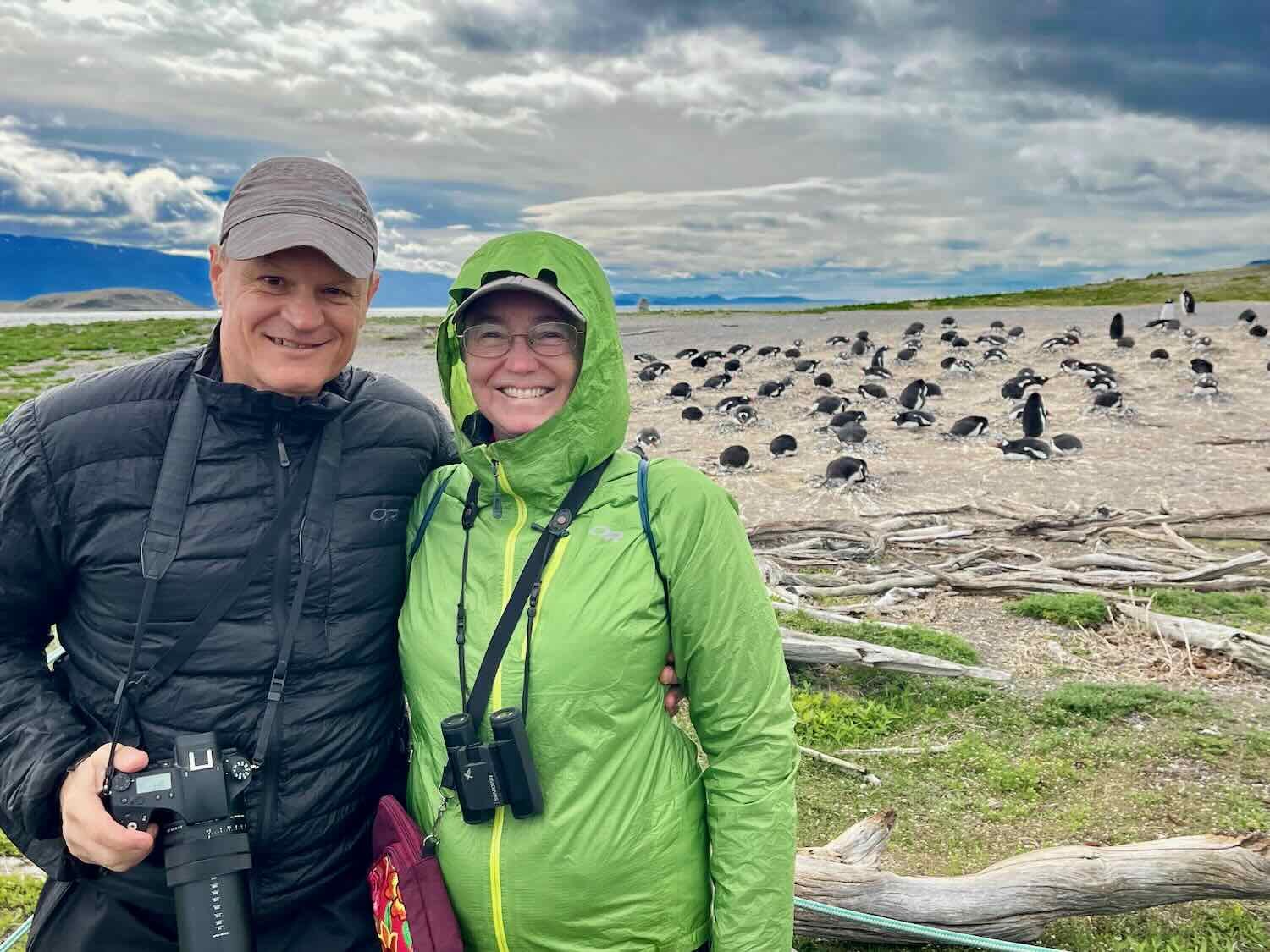
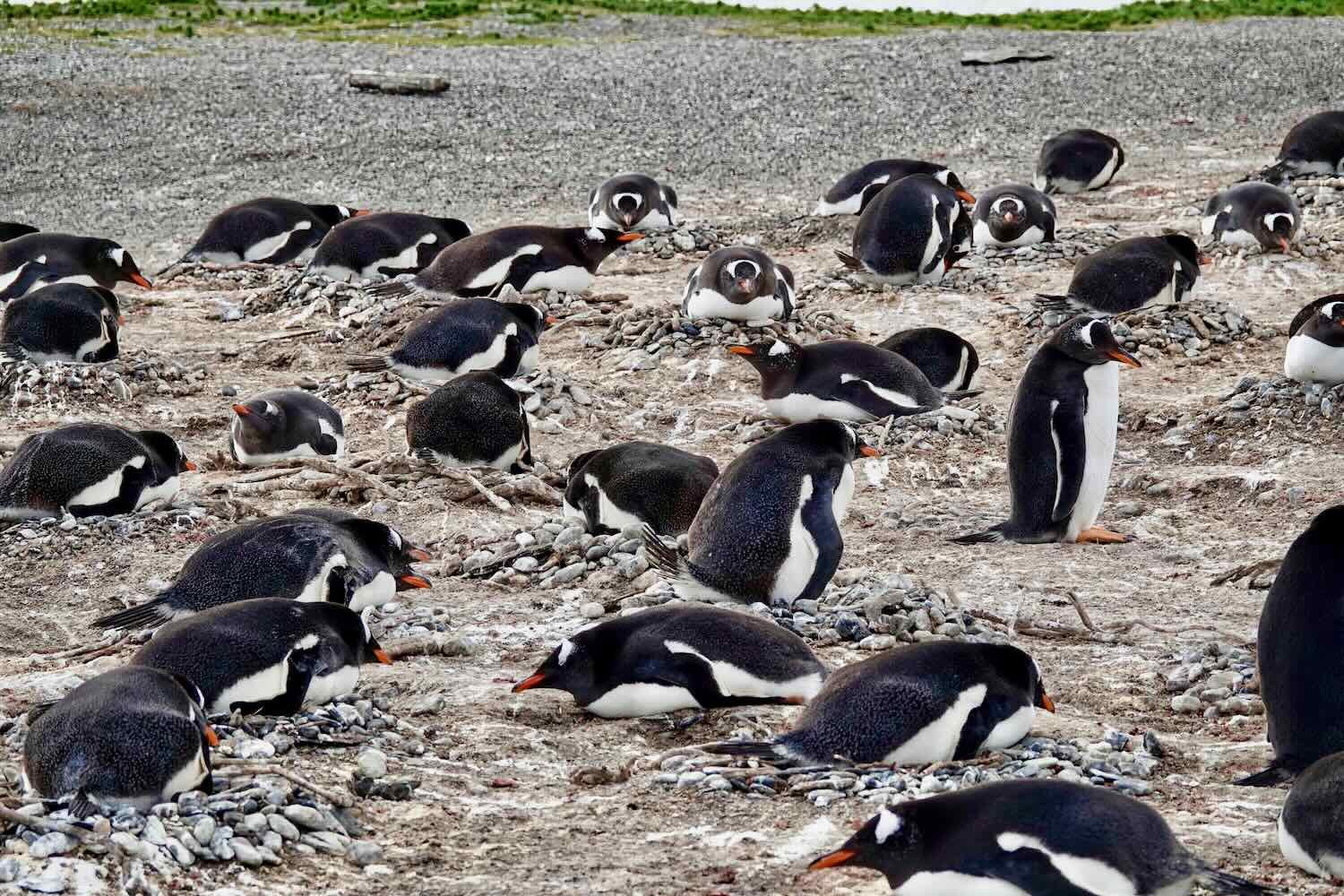
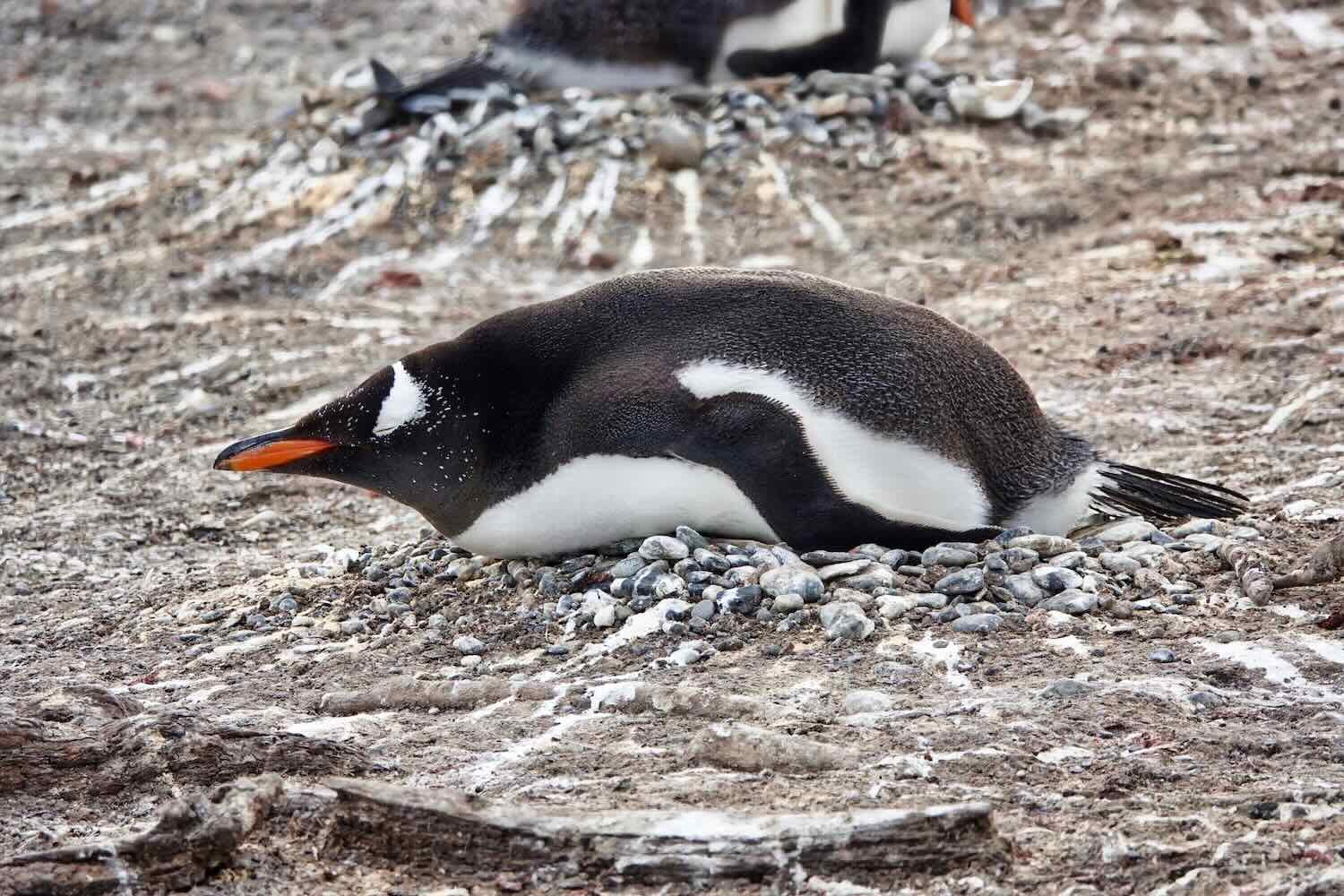
On the way back to Ushuaia from the penguin colony, our tour stopped at the small, but fascinating, Acatushún Museum. The museum houses the preserved skeletons of marine mammals and birds that have washed ashore on the beaches of Tierra del Fuego. Some of the full skeletons were beautifully displayed next to life-sized, wall paintings of the animals they came from. What made the visit special, though, was the guided tour provided by one of the staff. He shared a ton of knowledge about the various types of marine mammals found in the area, with a lot of interesting details. It was a great way to end our visit to see the penguins.
The skeletons of marine mammals found in Tierra del Fuego were artfully displayed in the Acatushún Museum. Estancia Harberton, Tierra del Fuego, Argentina. Copyright © 2019-2024 Pedals and Puffins.
The big canines on this Leopard Seal skull looked like they could really do some damage. Leopard seals are the only species of seals that routinely eat other warm-blooded mammals. Although they rarely come into contact with people because of their frigid, polar habitat, they have attacked people in the past. Acatushún Museum, Estancia Harberton, Tierra del Fuego, Argentina. Copyright © 2019-2024 Pedals and Puffins.
A Park Named Tierra del Fuego
Near the end of our stay in Ushuaia we took our unloaded bikes on a ride west of Ushuaia towards Tierra del Fuego National Park. The road to the park wound through a picturesque valley blanketed with meadows, bordered by the tree-lined foothills of the Martial Mountains (part of the Andes mountains that run the length of South America). It was a great way to shake some of the cobwebs off of our legs, and get ready for the road ahead.
If you go to the park, be aware that they charge foreign nationals $40 USD per person to enter. This is almost 10x the amount charged for citizens of Argentina. We thought that was a little excessive for a short ride around inside the park, so we decided to stop at the entrance and return to Ushuaia.
Entrance to the Tierra del Fuego National Park, Argentina. Copyright © 2019-2024 Pedals and Puffins.
View across the valley of the Río Pipo. West of Ushuaia, Tierra del Fuego, Argentina. Copyright © 2019-2024 Pedals and Puffins.
The Río Pipo cut a channel through some rocks. West of Ushuaia, Tierra del Fuego, Argentina. Río Pipo. Ushuaia, Tierra del Fuego, Argentina. Copyright © 2019-2024 Pedals and Puffins.
We had never been this far south before, so almost every bird we saw was a new species for us. The shoreline of the Beagle Channel near Ushuaia kept us busy identifying the variety of gulls, geese and ducks we had never seen before:
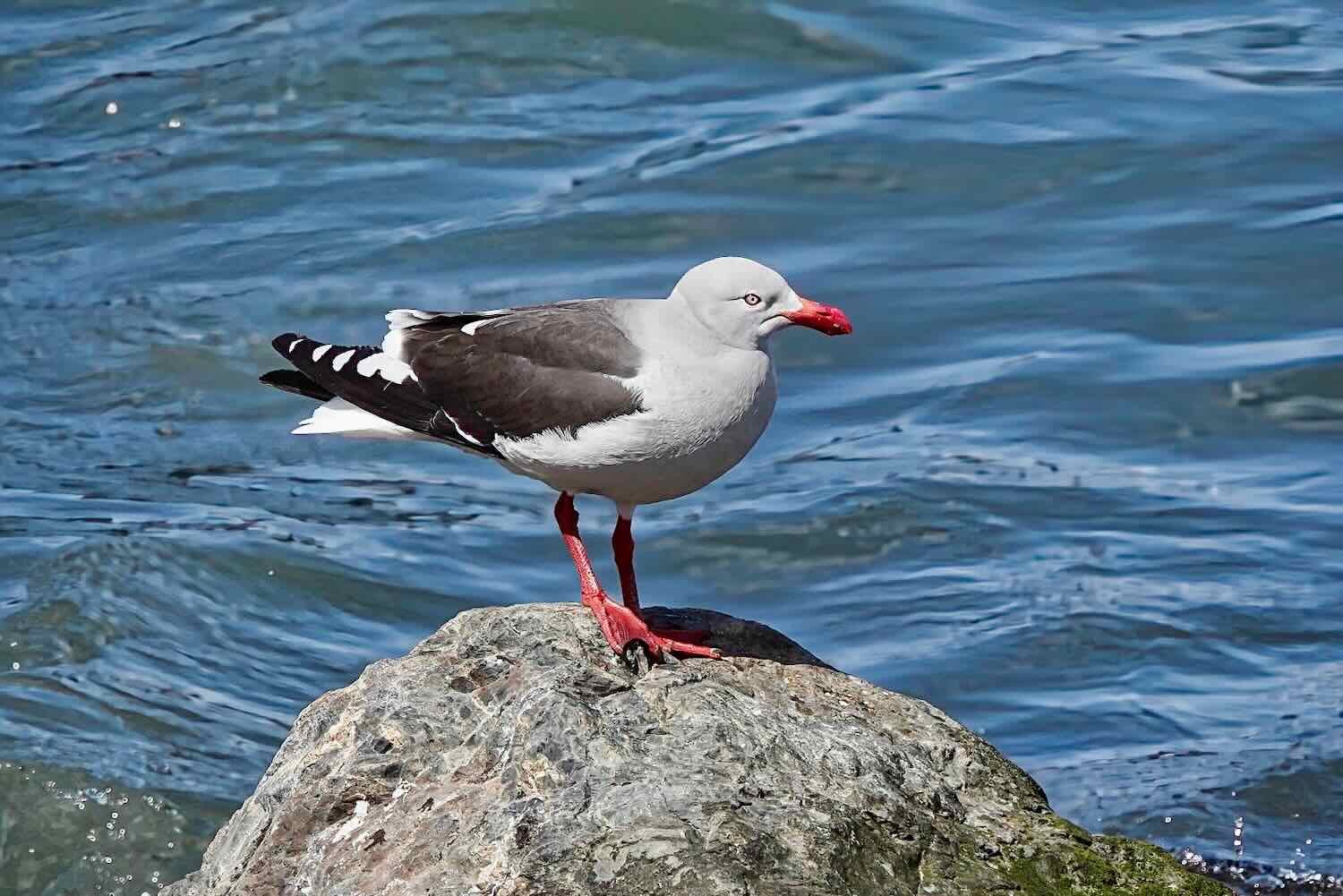
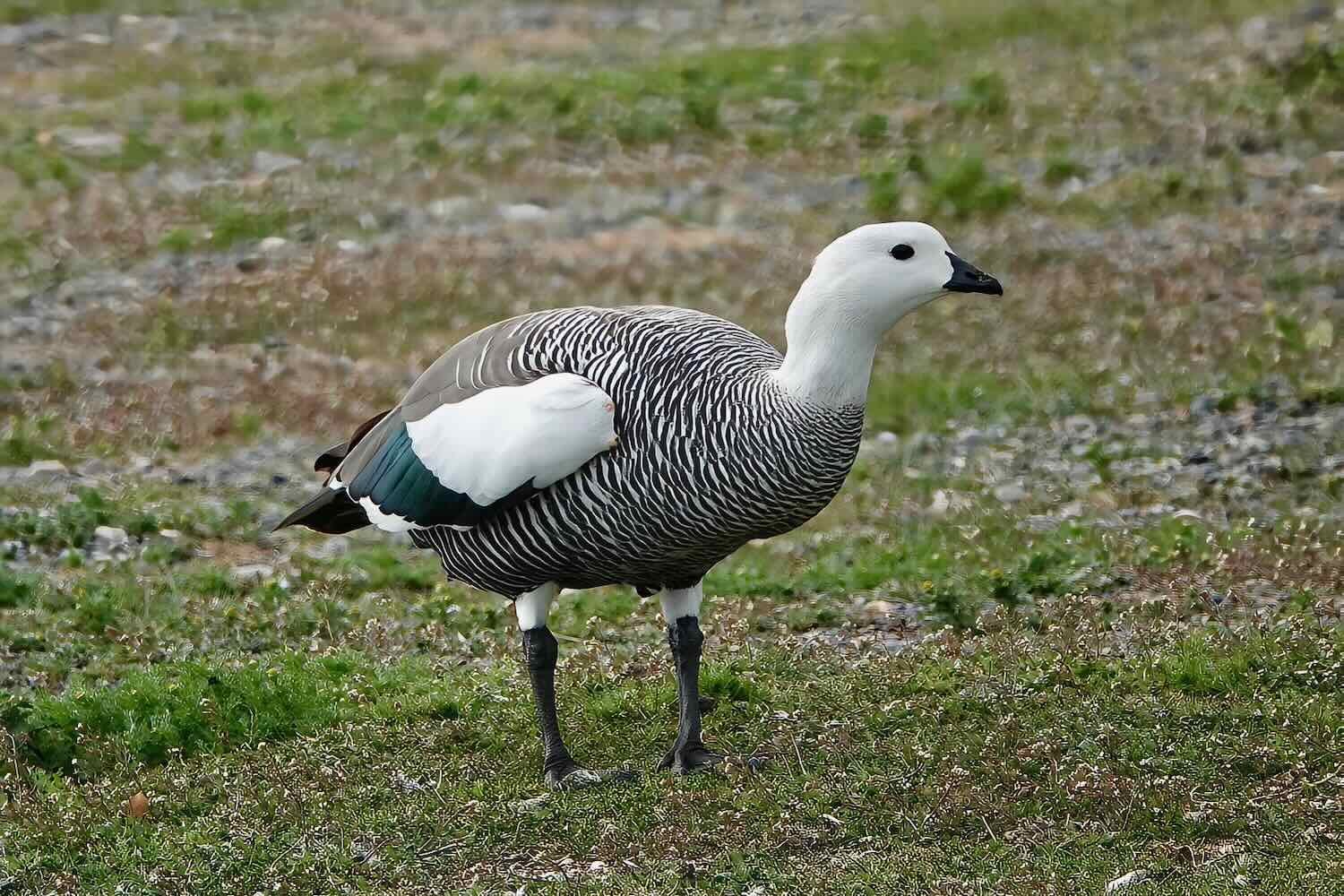
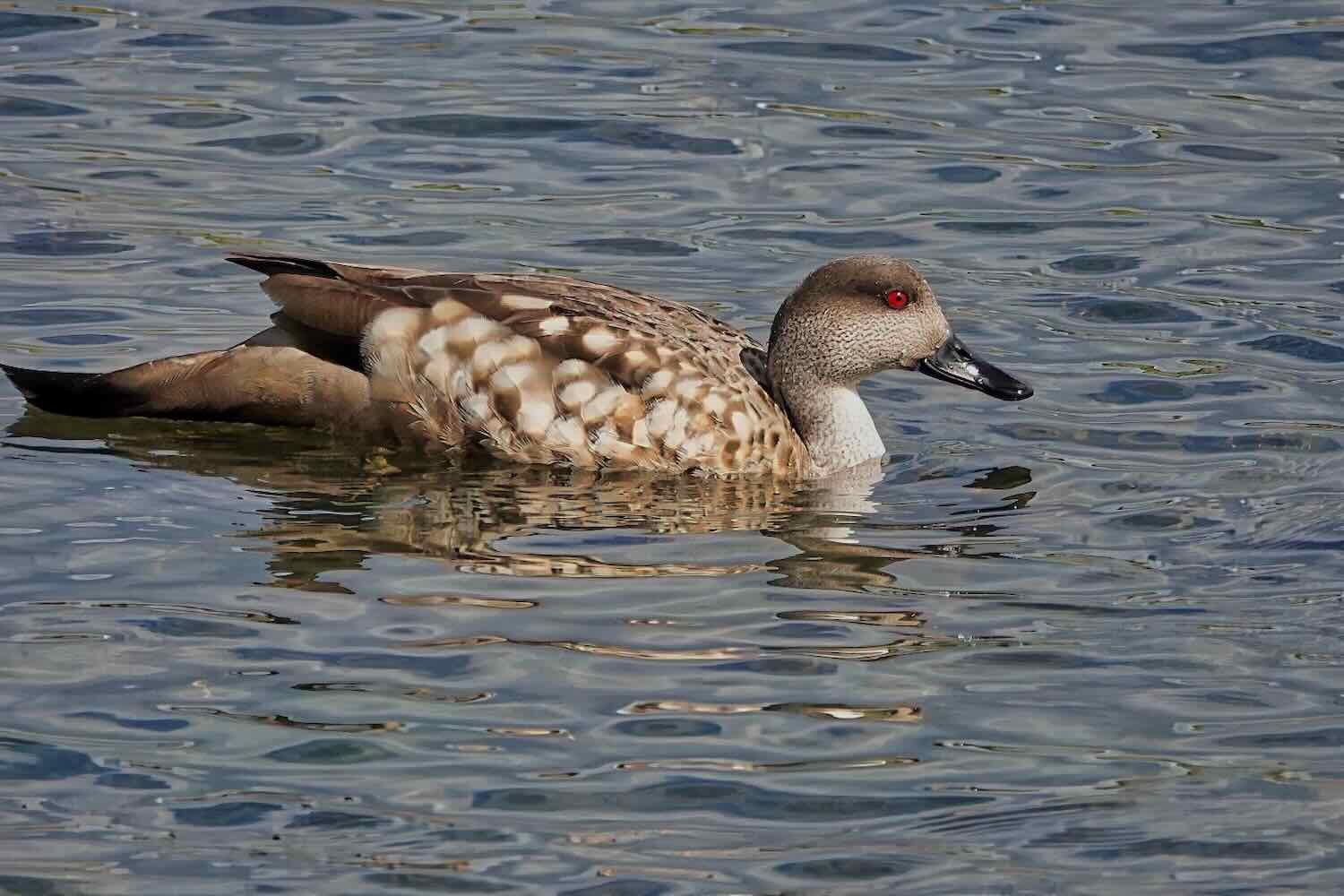

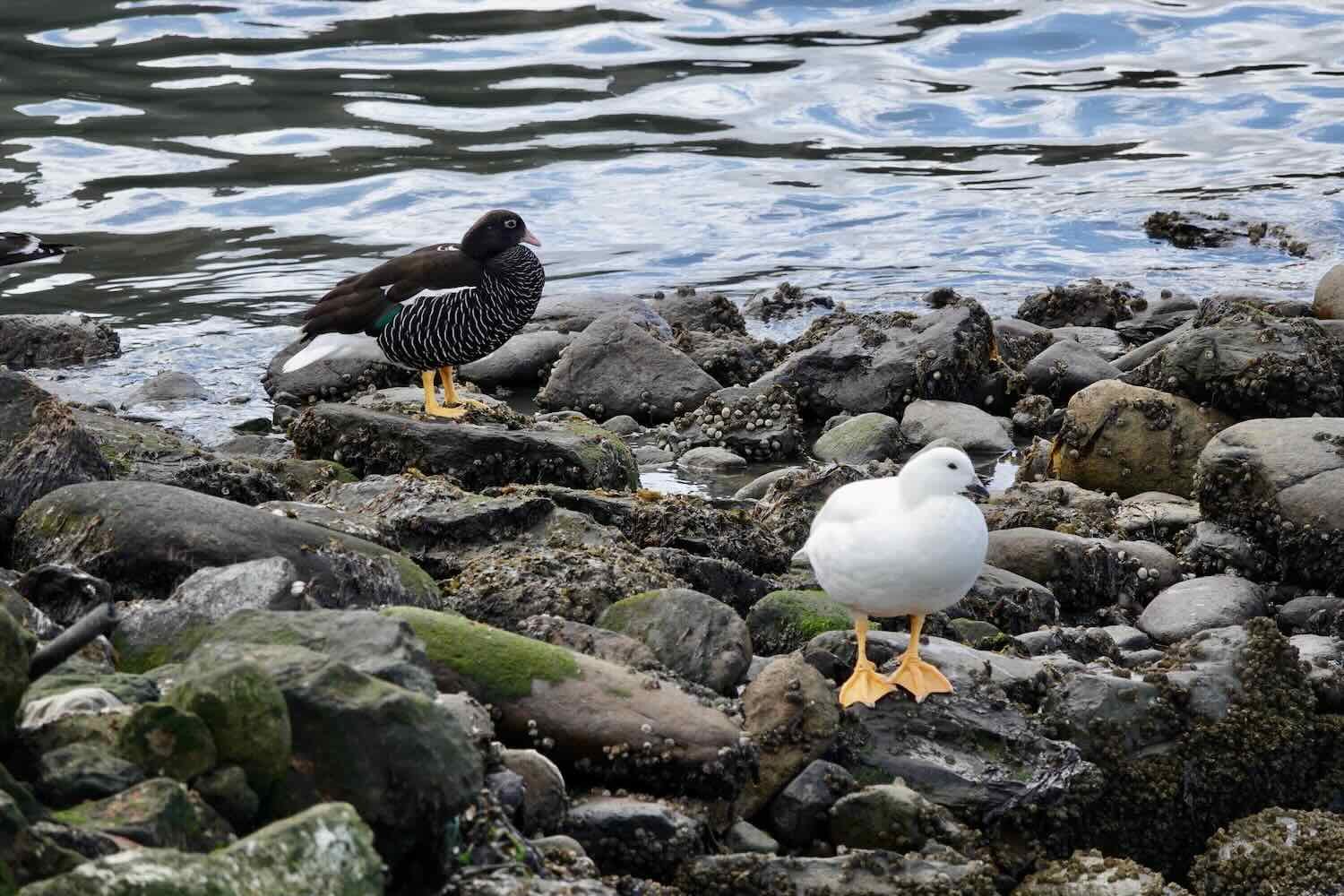
Delayed by the Weather
When planning our departure by bicycle from Ushuaia, we were very focused on one thing: the Wind.
We write that word with a capital ‘w’ because the Wind in Patagonia is on a whole other level than almost anywhere else in the Americas. Yes, we had cycled in some big winds in Central America (most notably on the Isthmus of Tehuantepec in Mexico, and through the Papagayo Jet in Costa Rica). But in those cases we could typically cycle from town to town, finding refuge from the gales in cafes and hotels.
Patagonia is not like that. There are long expanses of open grasslands where it can take several days to cycle between human settlements, and where the Wind can blow at 30-60 mph (50-100 kph) almost constantly. It can be very difficult to find a place sheltered enough from the Wind to pitch a tent that won’t blow down. As a result, cyclists in Patagonia become hyper-sensitive to the Wind, and do their best to travel during periods when the Wind doesn’t blow so hard.
However, as the day for our departure from Ushuaia approached, we began to have second thoughts. The forecast called not just for wind, but quite a bit of rain as well. So we did the sensible thing, and hunkered down indoors for two more days. That turned out to be a really good decision, because a nasty storm blew through the area with near-freezing rain, quite a bit of hail, and even some snow over night.
As we prepared for departure from Ushuaia, a big storm blew through the area, covering the mountains with a fresh blanket of summer snow. Ushuaia, Tierra del Fuego, Argentina. Copyright © 2019-2024 Pedals and Puffins.
Beautiful, snow-shrouded mountains surrounding Ushuaia, Tierra del Fuego, Argentina. Copyright © 2019-2024 Pedals and Puffins.
A Wet Climb Into the Mountains
Finally, after nine days in Ushuaia, we were ready to depart. However, although we had wisely delayed our launch for a couple of days due to bad weather, it probably would have been smart to wait at least one more day. The problem was, we really wanted to get back on our bicycles. So in spite of the fact that we awoke to a gloomy morning, we decided to follow through with our plans and cycle out of the city hoping the weather would improve.
It was raining as we ate breakfast, so we took our time getting ready. When a break in the weather came around 10am, we convinced ourselves that this was the end of the storm, and crossed our fingers that we would have dry conditions for our ride northward.
At first, it seemed like our luck would hold. We pedaled out of Ushuaia under a few, light showers, which didn’t bother us at all. But before we reached the top of the first pass, less than two hours into our ride, we were cycling through a steady, rain.
Climbing out of Ushuaia through the Olivia River Valley. North of Ushuaia, Tierra del Fuego, Argentina. Copyright © 2019-2024 Pedals and Puffins.
Enjoying a break at the Carbajal Valley Overlook under stormy, gray clouds. North of Ushuaia, Tierra del Fuego, Argentina. Copyright © 2019-2024 Pedals and Puffins.
At this elevation, with cold, wet, wintery conditions, one starts to be a little concerned about hypothermia. After several hours of rain, we had become throughly soaked, and the risk and concern increased. On the descent off the top of the first pass, we spotted a building on the side of the road that looked like it might be a hotel. Our luck appeared to be changing. Anxious to find somewhere warm and dry, we stopped to check it out.
We first asked if they had any rooms available. We were not too disappointed they said ‘no,’ since it was still early in the day. Nonetheless, we were delighted to discover that they had a restaurant, with a roaring fire to provide heat. We parked our bikes under the eaves of the building (protected from the rain), and went inside to eat, warm up, and dry off.
The restaurant had an upscale, rustic feel, evoking a high-end ski lodge. There weren’t any other patrons when we arrived, so we were able to snag a table right next to the fireplace. Wow, a dream come true! Even better, we used a couple of restaurant chairs to hang up our very wet coats and gloves near the fire. Before long, we were feeling warm and almost dry.
Nothing is quite as satisfying as a roaring fire when you’ve been cycling in a cold rain. Tierra Mayor Restaurant, North of Ushuaia, Tierra del Fuego, Argentina. Copyright © 2019-2024 Pedals and Puffins.
View of the marshy valley outside the Tierra Mayor Restaurant. North of Ushuaia, Tierra del Fuego, Argentina. Copyright © 2019-2024 Pedals and Puffins.
It was fabulous. We ended up lingering there for two hours, snacking on empañadas and French fries, while sipping energy drinks and a couple of submarinos (hot chocolate). It felt amazing to be warm and dry again.
As we mounted our bikes to continue the ride, the rain was intermittent and much lighter. Once again, we hoped that the weather might finally clear. But we were wrong. By the time we were part of the way up the next pass, it was raining steadily again. Fortunately, the scenery was spectacular, helping to keep our spirits up.
Spectacular mountain views enriched our climb of Garibaldi Pass. North of Ushuaia, Tierra del Fuego, Argentina. Copyright © 2019-2024 Pedals and Puffins.
Around 5pm we found a place to camp along a gravel side road, hidden behind a hill, and surrounded by stunning, snow-dusted mountains. We were VERY lucky that the rain stopped long enough for us to set up the tent, allowing us to keep the inside of the tent and our sleeping gear dry. But by the time we were settled in, just an hour later, the rain had started falling again. We changed into dry clothes, piled our wet stuff in a corner of the tent, and got into our sleeping bags. Before too long, we had fallen asleep.
Our first Patagonian campsite, near the top of Garibaldi Pass. North of Ushuaia, Tierra del Fuego, Argentina. Copyright © 2019-2024 Pedals and Puffins.
The rain continued throughout the night, and well into the morning. The wind had also picked up again during the night, causing the fabric of our tent to flap around so that it was hard to sleep. We stayed buried in our sleeping bags wearing all of our dry clothes, in an effort to stay just warm enough to avoid shivering.
Descending to the Shores of Lake Fagnano
Finally, around 9am there was a break in the rain, allowing us to pack up our things. It was not very pleasant getting back into our very wet clothing. But we were eager to get rolling with the hope of an early arrival in the rural town of Tolhuin.
We spotted this lovely waterfall as we approached the top of Garibaldi Pass. North of Ushuaia, Tierra del Fuego, Argentina. Copyright © 2019-2024 Pedals and Puffins.
From the top of the pass, we had a gorgeous view of Lake Escondido - carved into a high mountain valley by a glacier. Garibaldi Pass Overlook, Tierra del Fuego, Argentina. Copyright © 2019-2024 Pedals and Puffins.
From the top of Garibaldi Pass, we descended swiftly out of the Martial Mountains through dense forests of southern beech trees - among only five species of trees native to this subpolar region.
Within a half hour we had reached the plains below, and arrived on the doorstep of another restaurant oasis. It was time for breakfast so we parked our bikes and headed inside. This restaurant was more informal than the last, with a low-key, rustic interior. Once again, the dining room was empty when we entered, so we grabbed the table closest to the wood stove and slowly dried out over the next 1.5 hours. A hearty bowl of delicious lentil stew was just the thing to warm our chilly bones.
Soaking up the heat from a wood stove at La Casona Restaurant. South of Tolhuin, Tierra del Fuego, Argentina. Copyright © 2019-2024 Pedals and Puffins.
Lamb, slow-roasting over an open wood fire. These open-pit grills are common in the area. La Casona Restaurant, South of Tolhuin, Tierra del Fuego, Argentina. Copyright © 2019-2024 Pedals and Puffins.
Across the street from the restaurant, a large, brick kiln made us wonder what was being manufactured. But we weren’t able to discover the answer. Near Lake Escondido, South of Tolhuin, Tierra del Fuego, Argentina. Copyright © 2019-2024 Pedals and Puffins.
Warm, dry and well-fed, we enjoyed the ride from the restaurant to the rural town of Tolhuin. For most of the way, our route followed the southern shore of Lake Fagnano, the largest lake in Tierra del Fuego.
Along the way, we rolled gently over sandy, glacial hills topped with stunted southern beech forests and separated by wetlands inhabited by beavers. The beavers aren’t native here - they were introduced to provide a source of income for locals (from the beaver pelts). But people say that the pelts aren’t very good quality, and there are no natural predators, so the beavers have proliferated to the point where nearly every little stream has a beaver dam and lodge. Even though beavers are beloved by many in the far North where they are native, here in the far South they are considered to be invasive pests.
A beaver lodge rose out of a flooded wetland. South shore of Lake Fagnano, Tierra del Fuego, Argentina. Copyright © 2019-2024 Pedals and Puffins.
Our path through the glacial hills. South shore of Lake Fagnano, Tierra del Fuego, Argentina. Copyright © 2019-2024 Pedals and Puffins.
Many of the stunted forests were full of old, dead wood. Apparently, when the trees die, the wood decomposes very, very slowly - leaving lots of skeletal trees scattered on the ground. South shore of Lake Fagnano, Tierra del Fuego, Argentina. Copyright © 2019-2024 Pedals and Puffins.
Although much of the land is held by private ranches, we saw very few domestic animals along this part of the route. This small group of horses was an exception. South shore of Lake Fagnano, Tierra del Fuego, Argentina. Copyright © 2019-2024 Pedals and Puffins.
Learning a few facts about the area. Lake Fagnano Overlook, Tierra del Fuego, Argentina. Copyright © 2019-2024 Pedals and Puffins.
The view out over Lake Fagnano. Tierra del Fuego, Argentina. Copyright © 2019-2024 Pedals and Puffins.
We rolled into the town of Tolhuin (pop. 10,000) a little before 5pm. At the entrance to town, we were greeted by statues depicting native Selk’nam men in their iconic, ceremonial paint. These nomadic hunters lived in traditional communities up until the early 1900s, and their images can be seen almost everywhere on the island. The red-and white body paint, combined with dramatic, over-sized masks, make them a favorite motif to evoke the fierce heart of Tierra del Fuego. Yet, as in many parts of the Americas, the natives of this region have either died or been assimilated so that the meaning behind these images has largely been lost.
Statue of a native Selk’nam man in ceremonial paint. Entrance to Tolhuin, Tierra del Fuego, Argentina. Copyright © 2019-2024 Pedals and Puffins.
A Night in a Bakery
When our original plan to stay in a local guesthouse turned out to be a bust, we found ourselves scrambling for another lodging option. Fortunately, Tolhuin is home to a super-sized bakery that lets traveling cyclists sleep in one of its basement storage rooms.
In fact, this casa de ciclistas (a.k.a., ‘cyclist’s house’) is very well known within the cycling community as a free refuge from the wind and weather along the Patagonian route. Cycle touring gives you the opportunity to sleep in some interesting places. We have slept in churches, community centers, fire stations, town parks, municipal buildings, deserted buildings, gas stations, and other “interesting places.” But, we had never slept in a bakery. We decided to give it a try.
Once we located the bakery and introduced ourselves to the staff, a young German employee who spoke English was tasked with showing us around. We walked across the street from the bakery, and entered the warehouse. After passing through aisles stacked high with bags of flour, we descended into a basement filled with boxes of other baking supplies.
To get to the casa de ciclistas, we walked past tall aisles of flour sacks in the bakery warehouse. La Union Bakery, Tolhuin, Tierra del Fuego, Argentina. Copyright © 2019-2024 Pedals and Puffins.
The sleeping area was downstairs, behind a wall of other baking supplies. Casa de Ciclistas, La Union Bakery, Tolhuin, Tierra del Fuego, Argentina. Copyright © 2019-2024 Pedals and Puffins.
There, in a back corner among the boxes, was a space with a double bunk bed, another single bunk, a wooden cabinet, and some lines to hang things to dry. The bathroom upstairs was shared with employees, and the bikes could be parked among the stacks of flour. It wasn’t anything fancy, but it was easy, free, well out of the wind, and available when we seemed to be out of options.
The bunks were in a back corner of the warehouse basement. Previous travelers had left a wealth of information on a map, taped to the side of a cabinet, which PedalingGal studied carefully. Casa de Ciclistas, La Union Bakery, Tolhuin, Tierra del Fuego, Argentina. Copyright © 2019-2024 Pedals and Puffins.
Some lines hung in a corner could be used to dry wet clothing - next to some old but still usable bike tires left behind by previous travelers (in case anyone was desperate). Casa de Ciclistas, La Union Bakery, Tolhuin, Tierra del Fuego, Argentina. Copyright © 2019-2024 Pedals and Puffins.
One of the three bunks was already occupied, as evidenced by the fact that someone had their stuff laid out on the bed. But he wasn’t around when we arrived. So we staked out our claims by putting some of our own gear on the other two beds, then headed up to the bakery for dinner.
The La Union Bakery is actually very fancy compared to the rest of the town. In fact, the old bakery burned to the ground in 2021, so the current building is practically brand new. And it’s incredibly busy, especially for such a small town. You have to take a ticket and wait until your number is called to be served. But the atmosphere was friendly and lively, and the staff all hustled cheerfully to fulfill the orders. So the wait wasn’t as bad as it might be otherwise.
The interior of the La Union Bakery is spacious and modern - having been rebuilt following a fire that burned the old bakery to the ground in 2021. It was really a surprise to see such a large modern building in the modest town. La Union Bakery, Tolhuin, Tierra del Fuego, Argentina. Copyright © 2019-2024 Pedals and Puffins.
The bakery is almost always so busy that you have to take a number and wait to be served. Fortunately, the staff hustle cheerfully, so the line moves pretty fast. La Union Bakery, Tolhuin, Tierra del Fuego, Argentina. Copyright © 2019-2024 Pedals and Puffins.
A Revolving Door of Cyclists
It was a busy night in the bakery’s warehouse basement. When we eventually returned to the sleeping area, the other cyclist who had arrived before us was already in bed, apparently asleep. Trying to be as quiet as possible, we changed our clothes and crawled into our sleeping bags on top of the old mattresses. We could hear the bakery staff working upstairs until around midnight.
Sometime in the dark of night - around 1-2 am - another cyclist arrived. Since there weren’t any more beds, he laid down in his clothes and covered himself with a space blanket and bivy sac on the cold, hard floor. He looked exhausted. And it was a good thing, because he did not appear to have a sleeping pad and rested directly on the concrete. As the saying goes, if you are tired enough you can sleep anywhere.
Somebody started snoring very loudly.
Then, in the wee hours of the morning - around 3 am - the first cyclist got up and left. Fortunately, all the rustling woke up PedalingGuy, because the first cyclist had accidentally grabbed PedalingGal’s coat on his way out, thinking it was part of his kit which had been scattered about. (In the other cyclist’s defense, the basement was dark, and he was undoubtedly tired and groggy from having just woken up.)
PedalingGuy jumped out of bed, chased after him and pointed out the mistake. Of course, he was surprised, apologized and sheepishly returned the coat before hopping on his bike and heading down the road. It is hard to imagine a piece of gear more important than a down coat in this cold climate. PedalingGuy was a hero!
Not wanting to miss an opportunity for some comfort, the second cyclist promptly moved from his spot on the hard, concrete floor and into the now-empty bed. But even after his late arrival the night before, this guy was up and gone, early the next morning.
PedalingGuy didn’t sleep much that night since he was preoccupied with all the coming and going, as well as having to do a jacket rescue.
PedalingGal, on the other hand, was sound asleep through the whole, busy night. Both of the other cyclists were gone when she woke up. PedalingGuy was very impressed that she was able to sleep through all the activity, the snoring, the jacket heist, and to top it off, she was on a top bunk that creaked and swayed every time she moved. PedalingGuy wondered several times through the night if he would have to jump up and keep her top bunk from falling over. Being able to sleep under those conditions is a real superpower on a cycling trip.
The next day we were able to find a cabin at the edge of town to rent for another night, so that PedalingGuy could catch up on some sleep. It was wonderful to have a clean, private space of our own. It rained off-and-on for most of the day, so we also were glad to be inside, out of the weather. We both rested peacefully that night, and woke up the next morning ready to get back on our bikes.
Guanacos, Foxes and Birds
Since arriving in Ushuaia, we had gradually become aware of an immutable fact regarding the weather in Tierra del Fuego: when there is less wind it rains. And when the sun comes out it gets very, very windy. There is one caveat however, which is that the mornings are sometimes calm. The more cycling you can do before 10am, the more likely you will enjoy at least a couple of hours of quiet before the gales begin to blow. This is probably the #1 reason that those other cyclists at the bakery departed so early in the morning.
By the time we were ready to leave Tolhuin, the rain that had soaked Tierra del Fuego for more than a week finally ended. Needless to say, we were looking forward to some dry cycling. The downside, however, was that we would have to contend with more Wind.
Unfortunately, we had not yet come to fully appreciate just how big of a difference in the quality of cycling there would be between the morning and midday hours. Plus, we had gotten in the habit of getting out of bed later because the recent mornings had all been very rainy. As a result, we got another late start in leaving Tolhuin - hitting the road a little after 10am.
On our way out of town, we saw this sign celebrating the region of Patagonia. North of Tolhuin, Tierra del Fuego, Argentina. Copyright © 2019-2024 Pedals and Puffins.
It didn’t take long before we realized that our late start was a pretty big mistake. The Wind in Patagonia had already gained momentum. We traveled on our bikes at an average speed of around 3-6 mph (5-10 km/h) for most of the day because of the stiff headwind. It was like going up a steep hill all day. And this time there were no cozy restaurants where we could stop for a break.
Our route took us almost due north. At first, the low, glacial hills were topped with scruffy forests of short, gnarly, weather-beaten trees. But ever so slowly, the surrounding hills grew farther apart, and the grass-covered valleys in between grew bigger and wider. We were gradually crossing the transition zone out of the subpolar forests that surrounded Ushuaia, and into the fabled Patagonian steppe - the cold, dry, grasslands that cover most of southern Argentina.
We knew that the steppe was home to guanacos - the wild ancestor of domesticated llamas - and hoped that we might be able to see one, eventually. So we were pretty excited to see our first guanaco-crossing road sign.
Look! This sign was evidence that guanacos cross the road near here. North of Tolhuin, Tierra del Fuego, Argentina. Copyright © 2019-2024 Pedals and Puffins.
We couldn’t believe our luck when, moments later, a big guanaco ran across the road ahead of us! It was kind of far away, but we still managed to get a photo of the handsome animal when it stopped to look back at us from the opposite side of an expansive field. Guanacos are really big, impressive animals, standing around 6 ft tall (2 m) and weighing up to 300 lbs (140 kg). Seeing one in the wild was a genuine thrill.
Our first guanaco sighting. This handsome animal had crossed the highway ahead of us, and stopped to look back once it reached a safe distance. North of Tolhuin, Tierra del Fuego, Argentina. Copyright © 2019-2024 Pedals and Puffins.
Little did we know that guanacos are very, very common in Tierra del Fuego. A key reason is that humans have exterminated their only predator - the puma - from the island. In fact, guanacos are so numerous in Tierra del Fuego that it is the only place in the world where the species is not listed as endangered. It is also the only place where hunting guanacos is legal. Guanaco is often seen on the menu in restaurants in the area. Even so, many of the guanacos we saw didn’t seem too afraid of us. And we ended up seeing a LOT of guanacos over the next couple of days.
Not long after seeing our first guanaco, we spotted another wonderful animal. South American gray foxes (a.k.a., chillas) also turned out to be fairly common. Over the course of the day we saw a couple of these silvery-gray foxes hunting for rodents in the grass not far from the road.
A South American gray fox (chilla) stopped to size us up while hunting along the roadside. North of Tolhuin, Tierra del Fuego, Argentina. Copyright © 2019-2024 Pedals and Puffins.
A weather-beaten ranch building. North of Tolhuin, Tierra del Fuego, Argentina. Copyright © 2019-2024 Pedals and Puffins.
Another guanaco, spotted across a field. This one was closer and more cooperative than the first one. North of Tolhuin, Tierra del Fuego, Argentina. Copyright © 2019-2024 Pedals and Puffins.
A little over three hours into our ride we saw another cyclist stopped by the side of the road, who was heading in the opposite direction (towards Ushuaia). We pulled over to say, ‘hi,’ and to introduce ourselves. We learned that Gilbert was from Chile. He had started his ride in Puerto Montt, Chile (at the northern end of the Carretera Austral or Southern Highway), and would end his journey in Ushuaia.
We were definitely jealous that he was riding with the wind at his back, but he didn’t really seem to relish cycling in the wind, either. He was hoping to make it to Tolhuin for the night, and then complete the final push to Ushuaia in one day after that - covering the distance in half the time that we required. In these conditions you can go more than twice as fast with the same level of effort when the wind is blowing with you, instead of against you! It is no coincidence that all the cyclists we have met are going South with the wind at their backs. This issue with the wind is something we knew about, but may not have fully appreciated when we decided to cycle north from Ushuaia.
The day’s ride didn’t have any big mountain passes. But cycling into the wind all day was tiring, and each small hill got more difficult as the day progressed. It was an awesome feeling when we finally arrived at our destination.
However, the gate of the campground was locked. There was a small house nearby, with smoke coming out of the chimney, so we suspected that someone was home. We waited a few minutes, hoping that someone would come out to greet us - but no one appeared. Then, after we yelled a few times, and just as we were starting to get concerned, a friendly woman came out and opened the gate to let us in.
The whole operation was very informal. The campground was large but we were the only ones there. Basically, she said that we could camp anywhere. There were some cleared areas with fire pits scattered throughout the property, so we walked around until we found one that we liked. A pleasant grove of stunted lenga beech trees helped to cut the wind, which was a wonderful relief. We set up our tent and settled in.
Our campsite among the stunted beech trees at Camping Norte Campground. The trees did a good job of sheltering our tent from the wind. North of Tolhuin, Tierra del Fuego, Argentina. Copyright © 2019-2024 Pedals and Puffins.
The forest also was home to a surprising variety of birds. We were particularly smitten by the arrival of a gorgeous, male, Magellanic woodpecker, with his scarlet-red head. We would later learn that this species is rather famous in the area. Images of the big, red-headed birds can be seen posted in hotels, in restaurants, and incorporated into wall murals.
A spectacular Magellanic woodpecker visited the trees near our campsite. As big as (or slightly larger than) the North American pileated woodpeckers, these birds are an impressive sight. Camping Norte, North of Tolhuin, Tierra del Fuego, Argentina. Copyright © 2019-2024 Pedals and Puffins.
A wind-twisted beech tree near our campsite. Camping Norte, North of Tolhuin, Tierra del Fuego, Argentina. Copyright © 2019-2024 Pedals and Puffins.
Arrival at the Atlantic Ocean
Camping Norte, where we spent the night, was barely a 10th of a mile (0.15 km) from the Atlantic Ocean. We spent most of the next day cycling within sight of the Atlantic. And before long, all of the trees that had previously lined the hilltops disappeared. We had entered the true Patagonian steppe, with only grasses and very low shrubs as far as the eye could see.
The day started off perfectly. We were not able to depart the campground until 9am, because that’s when they opened the gate. But the wind had died down over night, and it was a beautiful, calm morning. The sky even had extensive patches of blue, which was lovely.
We spotted a couple more South American gray foxes. But the real stars of the day were the guanacos. We saw TONS of guanacos in groups ranging from three to more than 20 animals. Often, one of the guanacos would be standing at the top of a high hill, apparently serving as a lookout for the others. When we would stop to have a look, the sentry would let out a series of high-pitched whinnies (similar to a horse, but more rhythmic) to alert the rest of the group that there could be trouble. Some of the groups even had young ones, which were very cute.
We saw another South American gray fox (chilla) hunting for mice near the road. South of Río Grande, Tierra del Fuego, Argentina. Copyright © 2019-2024 Pedals and Puffins.
It was common to see a lone guanaco posted on a hill top, apparently serving as lookout for the rest of the group. South of Río Grande, Tierra del Fuego, Argentina. Copyright © 2019-2024 Pedals and Puffins.
Some guanacos walked along the waterfront, with the Atlantic Ocean in the background. Estancia Viamonte, South of Río Grande, Tierra del Fuego, Argentina. Copyright © 2019-2024 Pedals and Puffins.
Besides the endless fences that lined the road, we rarely saw signs of humans out on the Patagonian steppe. So it was a bit of a surprise to see this cluster of buildings that comprised the Estancia Viamonte, one of the massive ranches that control most of the rural land in southern Argentina. South of Río Grande, Tierra del Fuego, Argentina. Copyright © 2019-2024 Pedals and Puffins.
These two guanacos looked like twins, but they probably were just friends. Guanacos give birth to only one calf per season. South of Río Grande, Tierra del Fuego, Argentina. Copyright © 2019-2024 Pedals and Puffins.
A crested caracara surveyed its domain from its perch on a fence post. We are used to seeing this species only in warm, arid habitats, so it was fascinating to see them doing so well in the frigid south. Caracaras were common along the route, and they seemed bigger than the ones we had seen in Central America. South of Río Grande, Tierra del Fuego, Argentina. Copyright © 2019-2024 Pedals and Puffins.
Stopping for a quick, roadside break. Notice the total lack of trees or shrubs in the background. There’s nothing to stop the wind from blowing, here. South of Río Grande, Tierra del Fuego, Argentina. Copyright © 2019-2024 Pedals and Puffins.
A metal cross marks a spot known as Punta María along the Atlantic Coat. The tide was low, exposing a wide shelf of mussel beds and kelp. South of Río Grande, Tierra del Fuego, Argentina. Copyright © 2019-2024 Pedals and Puffins.
Once we passed Estancia Viamonte, we started seeing a few more cows and sheep (which had been almost completely absent further south). South of Río Grande, Tierra del Fuego, Argentina. Copyright © 2019-2024 Pedals and Puffins.
A pair of Coscoroba swans paddled slowly across a marshy pond. South of Río Grande, Tierra del Fuego, Argentina. Copyright © 2019-2024 Pedals and Puffins.
More infrastructure began to appear as we got closer to the town of Río Grande. This looked like some kind of oil or natural gas well. South of Río Grande, Tierra del Fuego, Argentina. Copyright © 2019-2024 Pedals and Puffins.
However, it’s rare to have a day where the wind doesn’t blow in Patagonia. And about halfway through our ride, the wind picked up with a vengeance. It was a headwind, of course, making the last three hours a lot harder. At least it didn’t rain. On the contrary, there was quite a bit of sun and we both ended the day with sunburned faces.
Did we mention that there were strong winds? South of Río Grande, Tierra del Fuego, Argentina. Copyright © 2019-2024 Pedals and Puffins.
One of the most endearing sights of the day was a litter of South American gray fox pups hanging out near their den. They were so small, that PedalingGal thought the first one she saw was a rodent, before getting a better look. Luckily, they were curious enough to let us take their photo. South of Río Grande, Tierra del Fuego, Argentina. Copyright © 2019-2024 Pedals and Puffins.
Then, with six miles to go (9.5 km), our prayers were answered. Our route made a hard right turn towards town, and suddenly the wind was at our back. Our speed increased from roughly 4 mph (6.5 kph) to 16 mph (24 kph). It was a miracle. We sailed into Río Grande (pop. 99,200) with hardly any effort. By 5pm we were all cleaned up, well fed, and resting comfortably.
Waiting out the Weather in Río Grande
The next day, the wind continued to howl, with gusts topping 60 mph (95 kph). Furthermore, a glance at the weather showed that the next couple of days were going to be pretty stormy. Once again, we settled in to wait for an improvement before getting back on our bikes.
With lots of wind and rain, we didn’t get to spend a lot of time outside. However, we did get out for one long walk along the Atlantic Ocean waterfront. The tide was going out rapidly, exposing a big sand flat covered with little pebbles and lots of kelp.
A two-banded plover searched for a meal among the piles of kelp along the seashore. Río Grande, Tierra del Fuego, Argentina. Copyright © 2019-2024 Pedals and Puffins.
As the industrial capital of Tierra del Fuego, Río Grande feels a lot more like a regular city than Ushuaia, which is dominated by the tourist scene. In fact, it’s safe to say that Río Grande doesn’t have much in the way of tourist attractions at all. Even so, it is apparently popular among trout fishermen and the city hosted a surprising number of stores specializing in outdoor gear (mostly clothes), plus a few with fishing gear.
One evening we went out for dinner at the Confitería Roca, a little restaurant that had been in operation for over 50 years - which is a very long time in Tierra del Fuego. The food was good and plentiful, but the big draw was the historical memorabilia lining the walls. In particular, the restaurant apparently was a hangout for the Argentinian heavyweight boxer, Ringo Bonavena, in the 1960s and 1970s. Ringo was an international star, and is most famous for his hard-fought battles with Muhammad Ali (at Madison Square Garden) and Joe Frazier (at the Spectrum in Philadelphia) - although he lost both those fights. We got a kick out of the photos of Ringo Bonavena, his coaches, and posters from his famous fights that crowded the walls inside the restaurant.
Memorabilia from the career of Argentinian heavyweight boxer Ringo Bonavena lined the walls inside the Confitería Roca restaurant. Río Grande, Tierra del Fuego, Argentina. Copyright © 2019-2024 Pedals and Puffins.
But with the Christmas holidays fast approaching, we couldn’t linger in Río Grande too long. As soon as the weather cleared, we would be back on the road. Our goal was to make it to Chile in time for the holidays. Hopefully the wind and rain would cooperate with our plans.
With Christmas approaching quickly, decorations started appearing all over town - like this Santa’s cap on the city’s ‘letras’ sign. Río Grande, Tierra del Fuego, Argentina. Copyright © 2019-2024 Pedals and Puffins.
